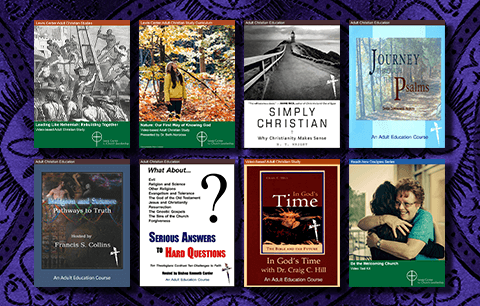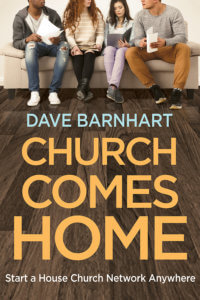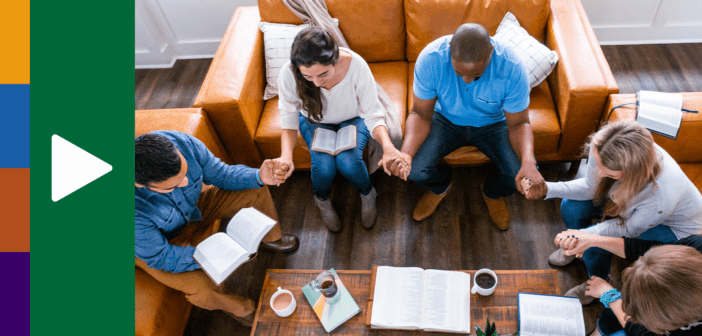
The pandemic taught us that church happens in powerful and meaningful ways outside our buildings. Dave Barnhart describes how small, home-centered worshiping communities can connect with people who may never cross the threshold of your church.
Listen on Apple Podcasts | YouTube Music | Spotify
>>> Watch on YouTube
- Transcript — Click or Tap to Read
-
Announcer: Leading Ideas Talks is brought to you by the Lewis Center for Church Leadership of Wesley Theological Seminary in Washington, DC. Subscribe free to our weekly e-newsletter, Leading Ideas, at churchleadership.com/leadingideas.
Leading Ideas Talks is also brought to you by adult Christian study curriculum from the Lewis Center. Bring the best of contemporary Christian scholarship to your congregation’s in-person and online small groups and classes with video-based curriculum that encourages energetic discussion and personal reflection on a number of subjects. Studies include Journey through the Psalms, Simply Christian, Religion and Science, Nature: Our First Way Of Knowing God, and many more. Learn more, watch sample videos, and order now at churchleadership.com/studies.
The pandemic taught us that church happens in powerful and meaningful ways outside our buildings. In this episode Dave Barnhart describes how small, home-centered worshiping communities can connect with people who may never cross the threshold of your church.
Ann Michel: I’m Ann Michel, one of the editors of Leading Ideas e-newsletter, and I’m the host for this episode of Leading Ideas Talks. I’m speaking today with Dave Barnhart who is pastor of Saint Junia, which is a network of house churches in Birmingham, Alabama. He’s also the author of the book, Church Comes Home: Start a House Church Network Anywhere. I’m so excited to be speaking with him today about the potential of the house church movement and about what those of us who are in what he calls “legacy churches” can learn from the experience of house churches. So, welcome Dave. It’s good to have you with us.
David Barnhart: Thanks. It’s great to be here.
Ann Michel: I wondered if you could just very briefly share a bit of your story of how you got involved as a planter and leader of house churches.
David Barnhart: Sure. I have had an idea that I wanted to start a church for a long time, especially for my own affinity group who are people who’ve been hurt or burned by church or who don’t feel like they fit in church. We live in Alabama, which is one of the most churched places around. But it also means that people who may be seeking or may be unchurched feel very isolated and very marginalized by the Christian fundamentalist culture that we live in.
In 2012 I went to some church planting trainings and various kinds of boot camps in the Methodist church, and we started a church in 2012 that was really more of a conventional church. We had a band, we had a venue, and that sort of thing. But what we found was that a lot of people would have one of two reactions. People would either come and say, “Hey this is great!” but then they wouldn’t come back. Or they would tell me, “Hey, I love what you’re doing. I love your theology. I love the way you’re trying to reach people who don’t feel like they fit. I’m never going to church again, but I love what you’re doing.”
So, I struggled with how to create “sticking power.” And we found that the place we got the most traction was in our small groups that we were running at the time, so we sort of pivoted in 2016 to doing house churches, to really focusing on that smaller intentional group. That’s kind of where it blossomed. We’ve had a lot of success. At one point we had six house churches. And I think at the most, about half the people who were attending the church hadn’t been to church in six months, so I felt like we were really getting some good traction there.
In the process of learning about house church, we had to sort of adapt some of what was already out there. House church has been going on for a long time, since the beginning really. What we started doing was something that was a little more intentionally liturgical. We have a liturgy. We read scripture responsively. We have some guided prayer time. And then we have conversation. It’s really the conversation where I think a lot of the discipleship happens, so instead of me standing up and talking to people, they’re bringing their own perspectives. That’s where people were really getting the most spiritual growth, the most discipleship. And we started doing that in 2016 and have been doing it ever since. Of course, COVID has kind of thrown a wrench into things. But we’ve been meeting online and occasionally meeting in smaller groups, as well.
Ann Michel: So, for the sake of our listeners, could you define “house church” and how you see house churches as distinct from other religious gatherings that might happen either in people’s homes or in noninstitutional settings?
David Barnhart: I think one of the biggest confusions is oftentimes people think of house churches as small groups, and they do have a lot in common. But the idea is that this is the worshipping community getting together. Sometimes we sing. I’ll admit music is not great typically in a house church unless you’ve got some very talented people. But the focus really is that this is our worshipping community.
The way we do it is we have a liturgy. Oftentimes we use Common Prayer, which is by Shane Claiborne, Enuma Okoro, and Jonathan Wilson-Hartgrove. But we’ve recently started using Wil Gafney’s book, A Women’s Lectionary for the Whole Church Year, and creating a liturgy out of that. So, we have scripture readings, kind of call and response. When we meet, we do communion. And it’s really focused more on: This is the worship experience. This isn’t in addition to something else. So, I would say that’s one of the biggest differences.
There are certainly lots of other ways that discipleship happens in homes — small groups, book studies, you know a variety of things. And we do some of those things. We do book studies and service projects. But what really sets house churches apart is: This is the primary worshiping community. Usually, it’s a dozen to 20 people at the most, so it’s intentionally small. Anyway, that’s kind of it in a nutshell.
Ann Michel: So, you’re serving a network of house churches you have planted. Can you describe those communities and how they connect to one another?
David Barnhart: Sure. Again, I have to put an asterisk beside this because things have been different for the last two years because of COVID. At our peak we were doing six house churches, which, I’ll be honest, is a little too much for one person. Doing four house churches is about ideal. But they would meet at different times. Some would meet Wednesday nights. That was a group largely of people who worked on Sundays and couldn’t go to a Sunday church. We have groups that met in Birmingham and in Huntsville, so occasionally I would go back and forth between Huntsville and Birmingham to be with those different churches. We will often have one in the morning and one in afternoon, so I would typically drive around, but I also had some people who were sort of lay pastors who helped lead other house churches. And those would be the people I worked very closely with because I’m essentially training them to do what I’m doing. And that enabled me to reach people I wouldn’t otherwise normally reach.
We have one house church that’s led by a Black man who does a lot of work in HIV prevention, so he has access to people I would never reach. And I really feel like that is one of the powerful things about house churches. I have an intern working with me right now, a woman who’s reaching people who have been hurt by church and really wouldn’t trust a man as their pastor. And I feel like that is a way that we can overcome some of the church hurt that keeps people from accessing church and from hearing the Good News.
Ann Michel: So, what you were just sharing leads me to my next question. Because I think your book casts a very inspiring vision of how house churches can have the potential to reach people that other churches aren’t able to reach. But at the same time, something I really appreciated about your book was it was really very balanced and realistic in assessing both the strengths and the weaknesses of house churches. In fact, there’s one point in the book where you actually list some of the pros and cons of house churches. So, I thought that might be interesting for our listeners to know, as well. What do you see as some of the strengths of house churches and what are some of the limitations?
David Barnhart: Well, I definitely think the strength is its versatility. I feel like house churches really get that sense of “Jesus throws the seed and wherever the seed lands a house church can grow.” I mean it really is this very distributed model of how we reach a wide variety of people. As a white, straight guy, there are people that I’m not going to reach, just because I’m automatically suspect, with good reason. But there are other things that are great about having a distributed network. Because if something happens to me, these other house churches are going to keep meeting. I don’t have to be present for them. And it’s such a simple model that it’s easily reproducible. Especially as I think about the future, things like COVID, things like climate change, and other global crises that we may face, I just feel like house churches are going to be very resilient because they’re not dependent upon top-heavy structure.
But there are things that house churches just can’t do, things that legacy churches are going to do better, just because there are economies of scale. You know, they’re going to be able to have more programs, especially for children and young people. They’re going to have a little more leverage to do things like buy medical debt for folks or whatever large programs they do. I think, though, that part of it is just recognizing that there are people in this world we live in now where there’s such distrust of institutions and distrust of institutions across the range. Whether people are conservative or liberal, whether we’re talking political institutions or faith institutions, people are just very suspicious right now — the most I’ve ever seen. To be able to still reach people who have questions about, you know, “Who you are really representing? And what’s your real angle?”, one of the things that house churches can do is say, “Come have dinner. Let’s have a conversation.” That’s where the genuine human connection happens. That’s where discipleship happens, I think.
Ann Michel: Your book was written, I think, just before the onset of COVID and the tremendous surge of interest in virtual ministry. And as I am reading about hybrid and virtual ministry, the subject of meeting in people’s homes as a companion to virtual ministry comes up repeatedly. So, given your definition and experience of house church, what are you seeing evolve now in a time when virtual ministry has become more popular?
David Barnhart: Well, I think our style fits really well with doing virtual ministry because music wasn’t one of our big strengths anyway. Conversation really is our strength. Webinars work really well for that style of participatory preaching. I usually talk for about 10 to 15 minutes and then most of the rest of it is conversation. And I have worship leaders, who typically are the leaders of other house churches, who are sort of my webinar conversation partners. And then we take comments from Facebook and YouTube and the Zoom chat. And it has worked really well.
I would say it’s been a little difficult. The thing is, if people are reluctant to go to church for health reasons, then they’re also not likely to want people in their homes for health reasons. There hasn’t been a lot of ability to sync up those things. But we’ve been doing a lot of meeting outside. And that’s more of a social thing, more of getting together for meals and conversation and that sort of thing, whereas worship happens online in the sort of conversational format.
Ann Michel: Do you imagine going forward that there might be house churches that exists solely in virtual space. Do you see that as an extension of the movement?
David Barnhart: I think that could be. I mean I certainly can see that as a possibility. It wouldn’t work as well for my folks, I think. Although I don’t know. I just said that, but then I question it. One thing people aren’t aware of is how many people out there have social anxiety and other things to prevent them from going to large gatherings. If you’re working with people who have some kind of disability or significant anxiety who don’t want to leave their home, then online is great. I do think, you know, we feel a loss in the fact that part of the strength of house churches is the intimate connection. There’s a loss of that. But I do think there are people, more than we often realize, who just have a real hard time getting out of the house.
 Adult Christian Group Study Curriculum
Adult Christian Group Study Curriculum
Bring the best of contemporary Christian scholarship to your congregation’s in-person and online small groups and classes with studies from the Lewis Center. Our video-based curriculum encourages energetic discussion and personal reflection on a number of subjects. Studies include: Journey through the Psalms, In God’s Time, Simply Christian, Religion and Science, Nature: Our First Way Of Knowing God, Serious Answers to Hard Questions, Leading Like Nehemiah, and more. Learn more, watch sample videos, and order now at churchleadership.com/studies.
Ann Michel: The way you’ve described your churches, some of them have kind of a niche character of bringing together people who have a certain affinity. And in a virtual space, you may have the ability to gather people, maybe who aren’t neighbors necessarily, who share that affinity.
David Barnhart: That’s definitely the case.
This is one thing I talked about in the book. This is very niche. If you’re after the people who aren’t going to come to church, you’re after a niche in recognizing how hard it is. All the church planting conferences I’ve gone to, all the trainings I went to, have a very triumphalist idea about gathering people or reaching the unchurched. Most of the time it’s about getting them to come to our thing, and I just feel like that’s not going to reach the people who aren’t already willing to come to your thing.
Ann Michel: Right. So “go to” rather than “come here.” One of the things that struck me during COVID, especially in the early months of the lockdown, was that there really was renewed attention to how people practice faith at home. And what first motivated me to pick up your book was I think that experience of the COVID lockdown really revealed to a lot of us, particularly mainline Protestants, that we haven’t really been equipped to live our lives of faith at home in terms of personal devotions, or fostering faith within our homes, or within our families. And so I wondered if there are any lessons from your work with house churches, for those of us who are part of what you call legacy churches, but are nonetheless interested in practicing faith more intentionally at home or in small gatherings?
David Barnhart: One of the first things that comes to mind is that we have had a tradition of doing an Epiphany House Blessing, which is a tradition that began in the Church of England, I think. I’m not sure where it actually began. But the idea is you chalk a blessing over your door, and there’s a little recitation that you do. It’s great to do with kids, especially if you can pick a kid up and hold them and let them chalk over the door. There’s stuff you can do like that, ritual that’s personally meaningful and that you really can do at home. I know this may sound a little scandalous, but when I think about the people who are interested in kind of “DIY religion,” people interested in New Age practices and that kind of stuff, so much of it is something you can do at home. Regardless of whether you agree with that or not, or if it fits with your theology, the point is they’re doing something at home, right? And so often what we do in legacy mainline denominations is, “Come here. This is where religion happens — at our location.” Giving people the tools to do ritual at home today connects them to something bigger than themselves. I think that’s so important, yeah.
Ann Michel: One of the things that I found most inspiring about your book was that it has a vision for a different leadership dynamic, really. And you wrote, when a pastor sits among many in a circle, instead of standing in front and preaching to an audience the dynamic changes. I’m a lay person and I’m pretty passionate about the idea of a more inclusive paradigm of ministry. So, I wondered if you could comment on the leadership dimension of house churches and what leadership development practices you are cultivating.
David Barnhart: My discipleship model is really based on Covenant Discipleship groups, which have this beautiful holistic idea of worship, devotion, compassion, and justice. We added witness to that so there’s five areas of discipleship. And part of the idea is that we’re always engaging each of those areas, both as individuals and then as a community. So, individual devotion, individual mercy; but, also, corporate worship, corporate justice. And then witness binds all that together in thinking about each of those areas of Christian leadership and teaching them to people — this is why we do justice; this is why we do devotion. And that really is something that the whole community possesses.
To make it a lived experience, the “sage on the stage” model of preaching just doesn’t work very well, right? There has to be a kind of “How are we living as community?” I do feel that house churches are closer to things like intentional community. You hear words like “the new monasticism” and that kind of stuff, which I resonate with. And I think there’s a craving for “What this means in my lived experience among my friends and my neighbors.”
Ann Michel: Thank you for that. It sounds like you are working to really mentor others to be lead churches themselves. What is that like?
David Barnhart: Yeah. It’s interesting because the way that it has happened for me is I’ve just sort of bumped into people who tell me they resonate with house churches. And occasionally I’ll make an appeal, “Hey, if you want to talk about starting a house church, ….” And someone will come to me and say, “I really think I’m ready to do this,” or “I’ve been thinking about this for a while, praying about this, and I feel like I have an ability to reach my friends who don’t go to church, who oftentimes express a longing. They’ve told me what they miss but that they’re not going back, for whatever reason. So, I want to create a community for them.”
I think God just provides those people. Here’s someone who has connections to someone I’m never going to have a connection to. And I just I work with that person to say, “This is how we do it.” And it’s an easily replicable model that can adapt to whatever their context is, whatever their cultural background is.
Ann Michel: Something else that intrigued me in your book was that you seem to really have in your mind the paradigm of innovation and change. You use some of the language of church innovation when you talk about how house churches can fail fast or the idea of starting a group for a trial period. You even talk about the house church movement as a disrupter in the broader church ecosystem. So can you speak to that? How you see house churches being an instrument of change and innovation?
Dave Barnhart: I do think — again, like you said — it is rapid deployment. You know, it doesn’t take $250,000 and four years of training to start a house church. You can launch it and, if it succeeds, great. If not, you don’t worry about it. Part of it is having a more “Buddhist mindset” about letting things go, right? If things happen, if they don’t succeed or work the way you had in your mind, it’s okay. You reached some people. Right? You had those life changing valuable conversations. And I think that’s really a ministry approach that the broader church needs, because we have such a corporate business mindset. Anything we do has to succeed, and it has to be “self-sustaining.” Even the very act of church planting, right? The metric for success is you plant and then after a certain number of years you are self-sustaining. You know, honestly, that’s just not going to happen with house churches. I’m aspiring now to be bi-vocational so that I can start more house churches, so that my income isn’t dependent on this process. And the fact is, most churches aren’t self-sustaining. They’re getting resources from other places. Honestly, the reason that they’ve grown in the way that they have, the reason we have megachurches, and the reason we have very large churches is more economic then spiritual. It’s because of the way that we extract resources and put them into business.
Ann Michel: Or there are churches that are being sustained through their legacy, the value of their property, their buildings, or their endowments, and if they had to sustain themselves based on their current revenue and expenses, they couldn’t do it. That only goes so far.
I’m curious. Since you’ve written on this subject, you must have a sense of this. Beyond your work in Alabama, is there a way of knowing how big this house church phenomena is either within the US or worldwide?
David Barnhart: Oh, man! It’s so impossible to measure because you have places like China where house churches are the dominant form of church. There have been people in the nondenominational world who’ve been doing house churches for ages.
You know, Frank Viola is one of the big names from the ‘80s and ‘90s who’s been planting house churches forever. I’m Methodist and our denominational structure is very interested in metrics. How do you measure all these different things? House churches are so fluid, and they’re so hard to count. Some of the research that Frank Viola did said that the average lifespan of a house church is between six months and two years, I think, so you’re not talking about something that’s going to be around for 100 years, that you can look at and point to and say “the membership is X number.” It’s much more amorphous. There are estimates that there are more people in house churches than are going to legacy churches, worldwide especially. And I don’t know how you could ever measure that.
And then you get in that fuzzy area. What do you consider church? Do they have to take up an offering? Do they have to do sacraments? What is it that counts as a church? Suddenly you’re in a whole messy theological question.
Ann Michel: Yeah, it does raise questions about your ecclesial definitions. When you said sustainability means you can pay a pastor and have a building, I think that is the de facto definition of church in our denomination whether we want to admit it or not. So I can see how it gets into that. To begin to draw things to a close, you call standing churches “legacy churches” — I have a hard time getting that out of my mouth, because in other circles “legacy churches” are those that are making a decision intentionally to die.
Dave Barnhart: Ouch!
Ann Michel: But to use your terminology, what are some of the key lessons that legacy churches can take away from what you’ve learned about house churches?
David Barnhart: I spent a good portion of my ministry in some more traditional legacy or institutional churches. One had a membership of about 3,000. One was a small country church. I think one of the important things is this idea of “programming.” In fact, I don’t even like the word anymore. I think so much of ministry needs to be more relational and not hang on to things that really ought to die. Oftentimes, we keep something going because we don’t want to hurt someone’s ego instead of saying, “Look, this thing was good. It served its purpose. Now let’s move on to something else.” To have more of a future orientation than the idea that I’ve invested in X and I need to keep it going — I think that’s one of the main things.
The other thing is the perception of a church ecosystem. One of the things I talked about in the book was we used the phrase “the institutional church,” and I just think it doesn’t describe the actual institution that includes publishers, consultants, academia. You know, we were just thinking about the denominational structures. That’s just one little piece of the full church ecosystem. And for me, I want to include those things that don’t get captured, the intentional communities of people who don’t go to church but who have a religious orientation in their lives. I call them the mystics and monastics, the people who gather in informal communities. All that is part of an ecosystem, instead of an “institution.” And I think those are important aspects of church life that often get pushed to the side or get ignored.
Ann Michel: Well, thank you for that. Thank you for this conversation, Dave. This is such an interesting subject. I learned so much from reading your book. In fact, the first time I read it, I was ready to go start my own house church! I really do think that there is something here that gets the essence of what our calling is as Christians and our calling to reach people that otherwise might not be reached by our ministry. So I want to thank you for adding this to our dialogue. And thanks for the wonderful conversation today.
David Barnhart: I appreciate it.
Announcer: Thank you for joining us for Leading Ideas Talks. Don’t forget to subscribe free to our weekly e-newsletter, Leading Ideas, to be notified when new episodes are published. Visit churchleadership.com/leadingideas.
 Related Resources
Related Resources
-
- Church Comes Home: Start a House Church Network Anywhere (Abingdon Press, 2020) by Dave Barnhart. The book is also available at Cokesbury and Amazon.
- Moving Beyond Church in A Box by Carey Nieuwhof
- The Bright Promise of Alternative Faith Communities by Ann A. Michel
- 7 Steps for Making Disciples Through Relational Mentoring by Ken Carter and Audrey Warren




